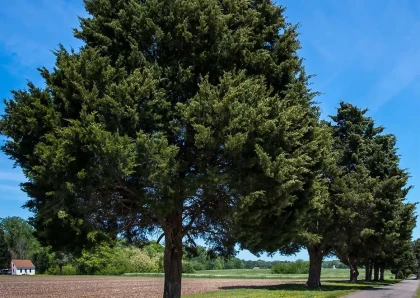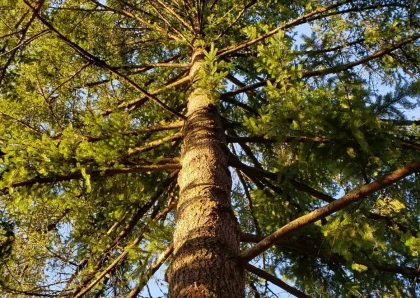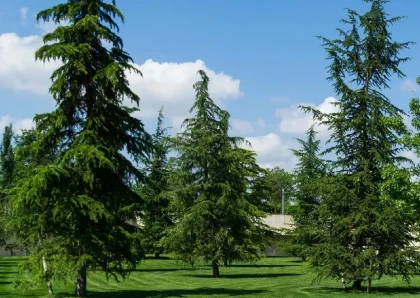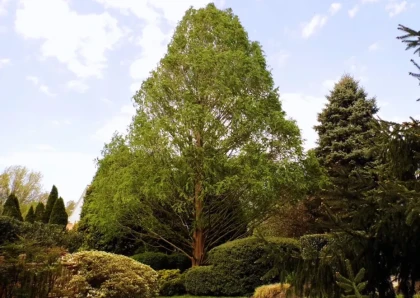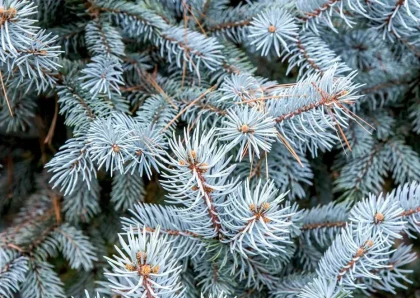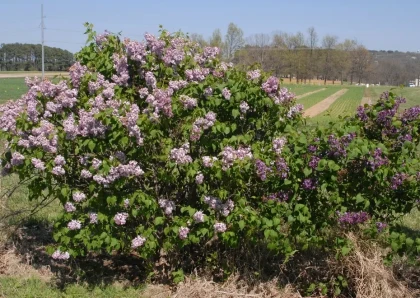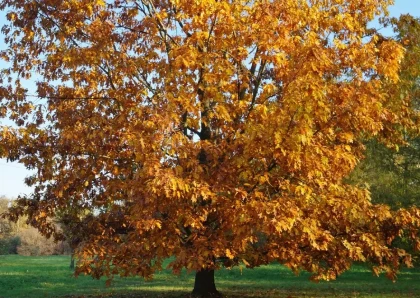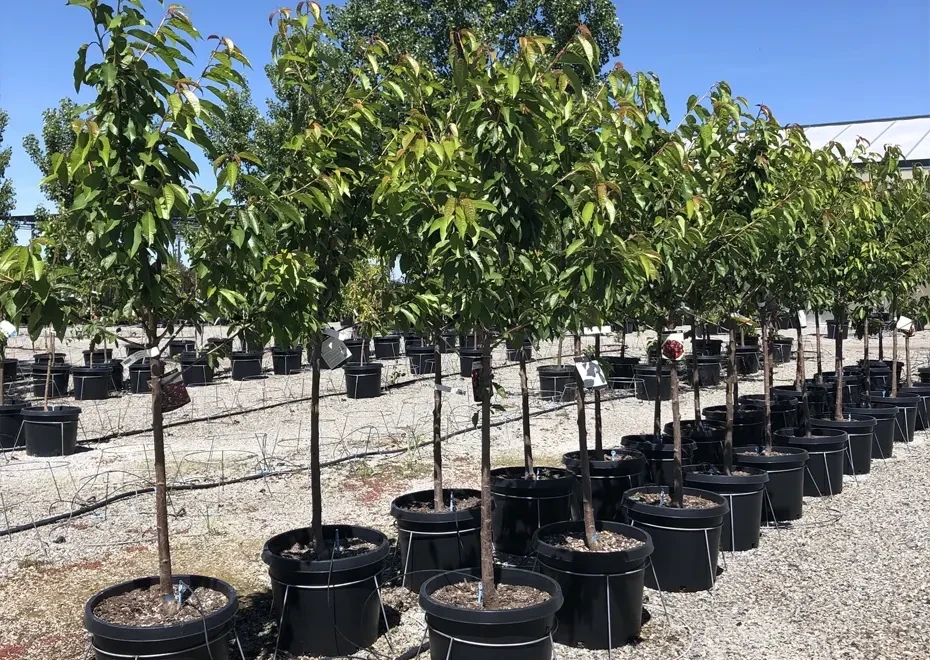
Bing Cherry Tree
Overview
Description
A Bing cherry tree is a type of fruit-bearing tree that produces Bing cherries, which are a popular sweet cherry variety. The Bing cherry is one of the most well-known and widely grown sweet cherry cultivars in the United States. It is known for its large, dark red to almost black cherries with a deliciously sweet flavor.
Characteristics of Bing Cherry Trees
- Appearance: Bing cherry trees are medium to large-sized deciduous trees with a round, spreading canopy. They typically grow to a height of about 20 to 30 feet (6 to 9 meters).
- Leaves: The leaves of the Bing cherry tree are dark green, glossy, and serrated along the edges. During the fall, they may turn various shades of yellow and red before dropping.
- Flowers: In the spring, Bing cherry trees produce clusters of small, white flowers. These flowers are attractive to bees and other pollinators, helping with fruit production.
- Fruit: The Bing cherry is a large, heart-shaped fruit with dark red to nearly black skin and juicy, sweet flesh. The cherries are typically ready for harvest in late spring to early summer, depending on the climate and growing conditions.
- Growing requirements: Bing cherry trees prefer full sun and well-draining soil. They require a certain amount of chill hours during the winter to set fruit properly. As such, they are best suited for temperate regions with distinct seasons.
- Pollination: Bing cherry trees are self-unfruitful, which means they need another cherry tree of a compatible variety nearby for cross-pollination to produce fruit effectively.
Bing cherries are not only enjoyed fresh but are also used in various culinary applications, such as pies, jams, and preserves. They are a popular choice among cherry lovers for their exceptional sweetness and delicious flavor.
Different Types of Bing Cherry Trees
- Early Bing: A variety that produces fruit a bit earlier than the classic Bing, perfect for regions with shorter growing seasons.
- White Gold Bing: This type yields golden-yellow cherries with a sweet and slightly tart taste.
- Black Republican Bing: A dark, almost black cherry variety with a rich and intense flavor, often used in desserts.
- Bing Royal: These cherries are a bit smaller but have an exceptionally sweet flavor, preferred by many cherry enthusiasts.
Wood Products from Bing Cherry Trees
Bing Cherry Trees provide high-quality wood that is sought after for various woodworking projects. The wood from these trees is prized for its beautiful grain patterns and rich color. Here are some different types of wood products that can be made from Bing Cherry Trees:
Furniture
Bing Cherry wood is often used to craft elegant and durable furniture pieces. It is popular for making cabinets, tables, chairs, dressers, and headboards. The wood's reddish-brown hue adds warmth and sophistication to the furniture.
Cabinetry
Bing Cherry wood is a favored choice for creating kitchen and bathroom cabinets. Its smooth texture and attractive appearance make it an excellent material for showcasing the beauty of the wood in these functional storage units.
Flooring
The durable nature of Bing Cherry wood makes it suitable for flooring applications. Its reddish-brown color develops a lovely patina over time, enhancing the charm of any room it adorns.
Interior Paneling
Bing Cherry wood is used for interior paneling, adding character and warmth to walls and ceilings. It can create a cozy and inviting atmosphere in homes and commercial spaces.
Wood Crafts
Artisans and hobbyists often use Bing Cherry wood for creating various wood crafts. From small decorative items like bowls and vases to intricate carvings and sculptures, the wood's fine grain lends itself well to craftsmanship.
Turning Projects
Bing Cherry wood is ideal for woodturning projects on a lathe. It can be shaped into beautiful bowls, spindles, and other rounded objects.
Benefits of Bing Cherries
- Antioxidant Properties: Bing cherries are loaded with antioxidants, such as anthocyanins and quercetin, which help neutralize harmful free radicals in the body, reducing oxidative stress and inflammation.
- Anti-Inflammatory Effects: The antioxidants in Bing cherries have anti-inflammatory properties, which may help alleviate symptoms of inflammation-related conditions like arthritis and gout.
- Heart Health: Bing cherries contain potassium, which supports heart health by regulating blood pressure and maintaining a healthy heart rhythm. The antioxidants also contribute to reducing the risk of heart disease.
- Improved Sleep: Bing cherries are a natural source of melatonin, a hormone that regulates sleep-wake cycles. Consuming cherries or cherry juice may aid in improving sleep quality and reducing insomnia symptoms.
- Muscle Recovery: The anti-inflammatory properties of Bing cherries can assist in reducing exercise-induced muscle damage and soreness. Athletes often use cherry juice as a post-workout recovery drink.
- Weight Management: Bing cherries are relatively low in calories and fat while providing a satisfying sweetness. They can be a healthy, nutrient-rich addition to a weight management plan.
- Digestive Health: Bing cherries are a good source of dietary fiber, promoting healthy digestion and preventing constipation.
- Brain Health: The antioxidants and anti-inflammatory compounds in Bing cherries may have a positive impact on brain health, potentially reducing the risk of neurodegenerative diseases.
- Skin Health: The antioxidants in Bing cherries can help protect the skin from damage caused by UV rays and pollution, contributing to healthier, younger-looking skin.
- Cancer Prevention: Some studies suggest that the antioxidants in cherries may play a role in reducing the risk of certain types of cancer.
Tips for Planting and Maintaining Bing Cherry Tree
-
Choosing the Right Location:
- Select a site with full sun exposure, as Bing Cherry trees require at least 6-8 hours of direct sunlight daily.
- Ensure the soil is well-draining, as cherry trees don't thrive in waterlogged conditions.
-
Soil Preparation:
- Prior to planting, prepare the soil by loosening it to a depth of about 18 inches and incorporating organic matter like compost.
- Test the soil's pH and aim for a slightly acidic to neutral pH level between 6.0 to 7.0.
-
Planting:
- Plant Bing Cherry trees in the early spring or fall when the tree is dormant.
- Dig a hole slightly larger than the root ball of the tree and place it at the same depth it was in the nursery container.
- Fill the hole with soil, tamp it down gently, and water thoroughly.
-
Watering:
- Newly planted trees need regular watering to establish their roots. Water deeply and consistently, especially during dry spells.
- Once the tree is established, water it deeply every 1-2 weeks during the growing season.
-
Mulching:
- Apply a 2-4 inch layer of organic mulch around the base of the tree, but keep it away from the trunk to prevent rotting.
- Mulch helps retain soil moisture, regulate temperature, and suppress weeds.
-
Pruning:
- Prune the tree during the dormant season (late winter or early spring) to remove dead or diseased branches and improve airflow.
- Thin out the center of the tree to allow light to penetrate and encourage fruiting.
-
Fertilizing:
- Use a balanced fertilizer in the early spring before new growth starts. Follow the manufacturer's instructions for application rates.
- Avoid excessive nitrogen fertilizers, as they can promote leafy growth at the expense of fruit production.
-
Pest and Disease Control:
- Regularly inspect the tree for signs of pests or diseases, such as aphids, cherry fruit fly, or bacterial canker.
- Apply appropriate insecticides or fungicides if necessary, following recommended guidelines.
-
Protecting from Wildlife:
- Use bird netting to protect the fruit from birds, as they are attracted to cherries.
- Consider using fencing or repellents to deter other wildlife that may damage the tree or fruit.
-
Harvesting:
- Bing Cherries are usually ready for harvest in late spring to early summer. Harvest when the fruit is fully ripe and easily detaches from the stem.
Cons of Planting Bing Cherry Tree
- Climate and Growing Conditions: Bing Cherry trees thrive in temperate climates with distinct seasons and a certain number of chill hours during winter. Unsuitable climates may result in poor fruit production or increased vulnerability to diseases.
- Space Requirements: Bing Cherry trees can grow quite large, reaching heights of 20 to 30 feet (6 to 9 meters) with a spreading canopy. Limited space or small gardens may not be ideal for such a large tree.
- Cross-Pollination Requirement: Bing Cherry trees are not self-fertile, requiring another compatible cherry tree nearby for proper pollination and fruit production. Lack of nearby cherry trees may affect fruit yield.
- Fruit Attracting Wildlife: The sweet and delicious cherries from the Bing Cherry tree can be attractive to birds and other wildlife. Without proper protection, wildlife can consume the fruit before harvest.
- Pruning and Maintenance: Cherry trees, including Bing Cherry, require regular pruning and maintenance. Improper pruning can reduce fruit production and increase susceptibility to diseases.
- Disease Susceptibility: Bing Cherry trees may be susceptible to certain diseases, such as bacterial canker and brown rot. Proper care and timely measures are necessary to prevent and manage these diseases.
- Insect Pests: Like other fruit trees, Bing Cherry trees may attract insect pests, such as aphids or cherry fruit flies. Regular monitoring and appropriate pest control methods may be necessary.
- Allergies: Some individuals may have allergies to cherry pollen, which could cause respiratory issues during the blooming season.
- Fruit Staining: Bing cherries have dark red to almost black skin, which can stain surfaces like driveways, walkways, and clothing if the fruit drops and gets squashed.
- Long Time to Bear Fruit: It can take several years (usually 3-5 years) for a young Bing Cherry tree to reach maturity and start producing fruit. Patience is required for the tree to become fully productive.
Conclusion
In conclusion, the Bing Cherry tree (Prunus avium 'Bing') is a popular and well-known sweet cherry variety that offers numerous benefits and rewards for growers and cherry enthusiasts. Its large, dark red to almost black cherries with a delectable sweet flavor make it a sought-after choice for both fresh consumption and various culinary applications.
The Bing Cherry tree requires specific growing conditions, including full sun exposure, well-draining soil, and a certain number of chill hours during winter. Planting and maintaining a Bing Cherry tree require careful attention to pruning, watering, fertilizing, and disease management to ensure its health and productivity.
When properly cared for, the Bing Cherry tree rewards gardeners with abundant harvests of delicious cherries, which are not only a delightful treat but also offer various health benefits. These benefits include antioxidant properties, anti-inflammatory effects, support for heart health, improved sleep, and potential positive impacts on brain and skin health.
However, it is essential to consider some potential challenges, such as the tree's large size and space requirements, the need for cross-pollination, susceptibility to pests and diseases, and the time it takes for the tree to reach maturity and produce fruit.
In making the decision to plant a Bing Cherry tree, one should carefully weigh the benefits and drawbacks based on their specific gardening conditions, available space, and desired fruit yield. With proper planning, care, and attention, the Bing Cherry tree can be a rewarding addition to any garden, providing years of delicious cherries and adding beauty to the landscape.
Frequently Asked Questions (FAQs)
1. What is a Bing Cherry Tree?
The Bing Cherry Tree (Prunus avium 'Bing') is a popular fruit-bearing tree known for producing delicious sweet cherries. It is one of the most widely grown cherry varieties in the United States.
2. How tall does a Bing Cherry Tree grow?
Bing Cherry Trees typically reach a height of about 20 to 30 feet (6 to 9 meters) with a round, spreading canopy.
3. When do Bing Cherry Trees bear fruit?
Bing Cherry Trees usually bear fruit in late spring to early summer, depending on the climate and growing conditions.
4. Are Bing Cherry Trees self-pollinating?
No, Bing Cherry Trees are not self-pollinating. They require another compatible cherry tree nearby for cross-pollination to produce fruit effectively.
5. What type of soil do Bing Cherry Trees prefer?
Bing Cherry Trees prefer well-draining soil with a slightly acidic to neutral pH level between 6.0 to 7.0. Soil that retains too much water can be detrimental to the tree's health.
6. How do I care for a Bing Cherry Tree?
To care for a Bing Cherry Tree, provide it with full sun exposure, regular watering during the growing season, proper pruning during the dormant season, and balanced fertilizer application. Protect the tree from pests and diseases, and ensure it has a nearby compatible cherry tree for cross-pollination.
7. Can I grow a Bing Cherry Tree in a small garden?
Bing Cherry Trees can grow quite large, so they may not be suitable for very small gardens or limited spaces. If you have space constraints, consider growing a dwarf or semi-dwarf cherry tree variety instead.
8. Are Bing Cherries healthy to eat?
Yes, Bing Cherries are not only delicious but also nutritious. They are a good source of antioxidants, vitamins, and minerals. Regular consumption of cherries may have various health benefits, including supporting heart health and reducing inflammation.
9. Can I eat Bing Cherries fresh off the tree?
Absolutely! Bing Cherries are best enjoyed fresh when they are ripe and fully mature. Pick the cherries when they are plump, dark red to almost black in color, and easily detach from the stem.
10. How long does it take for a Bing Cherry Tree to bear fruit?
It usually takes about 3 to 5 years for a young Bing Cherry Tree to reach maturity and start producing fruit. Patience is required for the tree to become fully productive.





